Chapter 9B. Signs
Section 9B.01 Application and Placement of Signs
Standard:
Bicycle signs shall be standard in shape, legend, and color.
All signs shall be retroreflectorized for use on bikeways, including shared-use paths and bicycle lane facilities.
Where signs serve both bicyclists and other road users, vertical mounting height and lateral placement shall be as specified in Part 2.
On shared-use paths, lateral sign clearance shall be a minimum of 0.9 m (3 ft) and a maximum of 1.8 m (6 ft) from the near edge of the sign to the near edge of the path (see Figure 9B-1).
Mounting height for ground-mounted signs on shared-use paths shall be a minimum of 1.2 m (4 ft) and a maximum of 1.5 m (5 ft), measured from the bottom edge of the sign to the near edge of the path surface (see Figure 9B-1).
When overhead signs are used on shared-use paths, the clearance from the bottom edge of the sign to the path surface directly under the sign shall be a minimum of 2.4 m (8 ft).
Figure 9B-1 Sign Placement on Shared-Use Paths
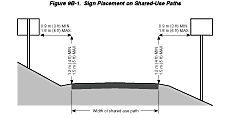
Guidance:
Signs for the exclusive use of bicyclists should be located so that
other road users are not confused by them.
The clearance for overhead signs on shared-use paths should be adjusted when appropriate to accommodate typical maintenance vehicles.
Section 9B.02 Design of Bicycle Signs
Standard:
If the sign applies to motorists and bicyclists, then the size shall
be as shown for conventional roads in Table 2B-1.
The minimum sign sizes for shared-use paths shall be those shown in Table 9B-1, and shall be used only for signs installed specifically for bicycle traffic applications. The minimum sign sizes for bicycle facilities shall not be used for signs that are placed in a location that would have any application to other vehicles.
Option:
Larger size signs may be used on bicycle facilities when appropriate.
Guidance:
Except for size, the design of signs for bicycle facilities should
be identical to that specified in this Manual for vehicular travel.
Support:
Uniformity in design includes shape, color, symbols, wording, lettering,
and illumination or retroreflectorization.
Section 9B.03 STOP and YIELD Signs (R1-1, R1-2)
Standard:
STOP (R1-1) signs (see Figure 9B-2) shall be installed on shared-use
paths at points where bicyclists are required to stop.
YIELD (R1-2) signs (see Figure 9B-2) shall be installed on shared-use paths at points where bicyclists have an adequate view of conflicting traffic as they approach the sign, and where bicyclists are required to yield the right-of-way to that conflicting traffic.
Figure 9B-2 Regulatory Signs for Bicycle Facilities
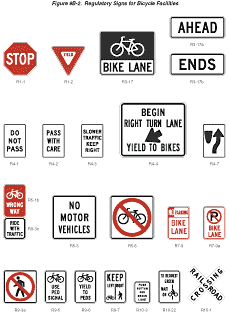
Option:
A 750 x 750 mm (30 x 30 in) STOP sign or a 900 x 900 x 900 mm (36
x 36 x 36 in) YIELD sign may be used on shared-use paths for added
emphasis.
Guidance:
Where conditions require path users, but not roadway users, to stop
or yield, the STOP sign or YIELD sign should be placed or shielded
so that it is not readily visible to road users.
When placement of STOP or YIELD signs is considered, priority at a shared-use path/roadway intersection should be assigned with consideration of the following:
- Relative speeds of shared-use path and roadway users;
- Relative volumes of shared-use path and roadway traffic; and
- Relative importance of shared-use path and roadway.
Speed should not be the sole factor used to determine priority, as it is sometimes appropriate to give priority to a high-volume shared-use path crossing a low-volume street, or to a regional shared-use path crossing a minor collector street.
When priority is assigned, the least restrictive control that is appropriate should be placed on the lower priority approaches. STOP signs should not be used where YIELD signs would be acceptable.
Section 9B.04 Bicycle Lane Signs (R3-17, R3-17a, R3-17b)
Standard:
The BIKE LANE (R3-17) sign (see Figure 9B-2) shall be used only
in conjunction with marked bicycle lanes as described in Section
9C.04, and shall be placed at periodic intervals along the bicycle
lanes.
Guidance:
The BIKE LANE (R3-17) sign spacing should be determined by engineering
judgment based on prevailing speed of bicycle and other traffic,
block length, distances from adjacent intersections, and other considerations.
The AHEAD (R3-17a) sign (see Figure 9B-2) should be mounted directly below a R3-17 sign in advance of the beginning of a marked bicycle lane.
The ENDS (R3-17b) sign (see Figure 9B-2) should be mounted directly below a R3-17 sign at the end of a marked bicycle lane.
Section 9B.05 BEGIN RIGHT TURN LANE YIELD TO BIKES Sign (R4-4)
Option:
Where motor vehicles entering an exclusive right-turn lane must
weave across bicycle traffic in bicycle lanes, the BEGIN RIGHT TURN
LANE YIELD TO BIKES (R4-4) sign (see Figure 9B-2) may be used to
inform both the motorist and the bicyclist of this weaving maneuver.
Guidance:
The R4-4 sign should not be used when bicyclists need to move left
because of a right-turn lane drop situation.
Section 9B.06 Bicycle WRONG WAY Sign and RIDE WITH TRAFFIC Plaque (R5-1b, R9-3c)
Option:
The Bicycle WRONG WAY (R5-1b) sign and RIDE WITH TRAFFIC (R9-3c)
plaque (see Figure 9B-2) may be placed facing wrong-way bicycle
traffic, such as on the left side of a roadway.
This sign and plaque may be mounted back-to-back with other signs to minimize visibility to other traffic.
Guidance:
The RIDE WITH TRAFFIC plaque should be used only in conjunction
with the Bicycle WRONG WAY sign, and should be mounted directly
below the Bicycle WRONG WAY sign.
Section 9B.07 NO MOTOR VEHICLES Sign (R5-3)
Option:
The NO MOTOR VEHICLES (R5-3) sign (see Figure 9B-2) may be installed
at the entrance to a shared-use path.
Section 9B.08 No Bicycles Sign (R5-6)
Guidance:
Where bicyclists are prohibited, the No Bicycles (R5-6) sign (see
Figure 9B-2) should be installed at the entrance to the facility.
Option:
Where pedestrians and motor-driven cycles are also prohibited, it
may be more desirable to use the R5-10a word message sign that is
described in Section
2B.36.
Section 9B.09 No Parking Bike Lane Signs (R7-9, R7-9a)
Standard:
If the installation of signs is necessary to restrict parking, standing,
or stopping in a bicycle lane, appropriate signs as described in
Sections 2B.39
through 2B.41,
or the No Parking Bike Lane (R7-9 or R7-9a) signs (see Figure
9B-2) shall be installed.
Section 9B.10 Bicycle Regulatory Signs (R9-5, R9-6, R10-3)
Option:
The R9-5 sign (see Figure 9B-2) may be used where the crossing of
a street by bicyclists is controlled by pedestrian signal indications.
Where it is not intended for bicyclists to be controlled by pedestrian signal indications, the R10-3 sign (see Figure 9B-2 and Section 2B.45) may be used.
The R9-6 sign (see Figure 9B-2) may be used where a bicyclist is required to cross or share a facility used by pedestrians and is required to yield to the pedestrians.
Guidance:
If used, the R9-5 or R10-3 signs should be installed near the edge
of the sidewalk in the vicinity of where bicyclists will be crossing
the street.
Section 9B.11 Shared-Use Path Restriction Sign (R9-7)
Option:
The Shared-Use Path Restriction (R9-7) sign (see Figure 9B-2) may
be installed on facilities that are to be shared by pedestrians
and bicyclists. The symbols may be switched as appropriate.
A designated pavement area may be provided for each mode of travel (see Section 9C.03).
Section 9B.12 Bicycle Signal Actuation Sign (R10-22)
Option:
The Bicycle Signal Actuation (R10-22) sign (see Figure 9B-2) may
be installed at signalized intersections where markings are used
to indicate the location where a bicyclist is to be positioned to
actuate the signal (see Section
9C.05).
Guidance:
If the Bicycle Signal Actuation sign is installed, it should be
placed at the roadside adjacent to the marking to emphasize the
connection between the marking and the sign.
Section 9B.13 Other Regulatory Signs
Option:
Other regulatory signs described in Chapter
2B may be installed on bicycle facilities as appropriate.
Section 9B.14 Turn or Curve Warning Signs (W1 Series)
Guidance:
To warn bicyclists of unexpected changes in shared-use path direction,
appropriate turn or curve (W1-1 through W1-7) signs (see Figure
9B-3) should be used.
Figure 9B-3 Warning Signs for Bicycle Facilities (2 Sheets)
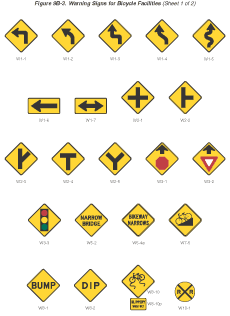
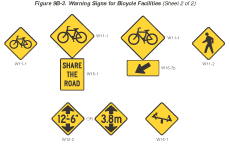
The W1-1 through W1-5 signs should be installed no less than 15 m (50 ft) in advance of the beginning of the change of alignment.
Section 9B.15 Intersection Warning Signs (W2 Series)
Option:
Intersection Warning (W2-1 through W2-5) signs (see Figure 9B-3)
may be used on a roadway, street, or shared-use path in advance
of an intersection to indicate the presence of an intersection and
the possibility of turning or entering traffic.
Guidance:
When engineering judgment determines that the visibility of the
intersection is limited on the shared-use path approach, Intersection
Warning signs should be used.
Intersection Warning signs should not be used where the shared-use path approach to the intersection is controlled by a STOP sign, YIELD sign, or a traffic control signal.
Section 9B.16 Bicycle Surface Condition Warning Sign (W8-10)
Option:
The Bicycle Surface Condition Warning (W8-10) sign (see Figure 9B-3)
may be installed where roadway or shared-use path conditions could
cause a bicyclist to lose control of the bicycle.
Signs warning of other conditions that might be of concern to bicyclists, including BUMP (W8-1), DIP (W8-2), PAVEMENT ENDS (W8-3), and any other word message that describes conditions that are of concern to bicyclists, may also be used.
A supplemental plaque may be used to clarify the specific type of surface condition.
Section 9B.17 Bicycle Warning Sign (W11-1)
Support:
The Bicycle Warning (W11-1) sign (see Figure 9B-3) alerts the road
user to unexpected entries into the roadway by bicyclists, and other
crossing activities that might cause conflicts. These conflicts
might be relatively confined, or might occur randomly over a segment
of roadway.
Option:
A supplemental plaque with the legend AHEAD or XXX METERS (XXX FEET)
may be used with the Bicycle Warning sign.
Guidance:
If used in advance of a specific crossing point, the Bicycle Warning
sign should be placed at a distance in advance of the crossing location
that conforms with the guidance given in Table
2C-4.
Standard:
Bicycle Warning signs, when used at the location of the crossing,
shall be supplemented with a diagonal downward pointing arrow (W16-7p)
plaque (see Figure 9B-3) to show the location of the crossing.
Option:
A fluorescent yellow-green background color with a black legend
and border may be used for Bicycle Warning signs and supplemental
plaques.
Guidance:
When the fluorescent yellow-green background color is used, a systematic
approach featuring one background color within a zone or area should
be used. The mixing of standard yellow and fluorescent yellow-green
backgrounds within a zone or area should be avoided.
Section 9B.18 Other Bicycle Warning Signs
Option:
Other bicycle warning signs (see Figure 9B-3) such as BIKEWAY NARROWS
(W5-4a) and Hill (W7-5) may be installed on bicycle facilities to
warn bicyclists of conditions not readily apparent.
In situations where there is a need to warn motorists to watch for bicyclists traveling along the highway, the SHARE THE ROAD (W16-1) plaque (see Figure 9B-3) may be used in conjunction with the W11-1 sign.
Guidance:
If used, other advance bicycle warning signs should be installed
no less than 15 m (50 ft) in advance of the beginning of the condition.
Where temporary traffic control zones are present on bikeways, appropriate signs from Part 6 should be used.
Option:
Other warning signs described in Chapter
2C may be installed on bicycle facilities as appropriate.
Section 9B.19 Bicycle Route Guide Signs (D11-1)
Guidance:
If used, Bicycle Route Guide (D11-1) signs (see Figure 9B-4) should
be provided at decision points along designated bicycle routes,
including signs to inform bicyclists of bicycle route direction
changes and confirmation signs for route direction, distance, and
destination.
Figure 9B-4 Guide Signs for Bicycle Facilities
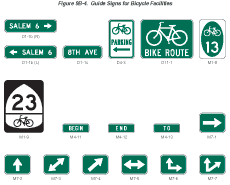
If used, Bicycle Route Guide signs should be repeated at regular intervals so that bicyclists entering from side streets will have an opportunity to know that they are on a bicycle route. Similar guide signing should be used for shared roadways with intermediate signs placed for bicyclist guidance.
Support:
Figure 9B-5 shows an example of the signing for the beginning and
end of a designated bicycle route on a shared-use path. Figure 9B-6
shows an example of signing for an on-roadway bicycle route. Figure
9B-7 shows examples of signing and markings for shared-use paths.
Figure 9B-5 Example of Signing for the Beginning and End of a Designated Bicycle Route on a Shared-Use Path
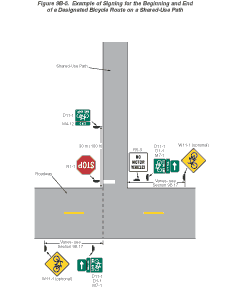
Figure 9B-6 Example of Signing for an On-Roadway Bicycle Route

Figure 9B-7 Examples of Signing and Markings for Shared-Use Paths
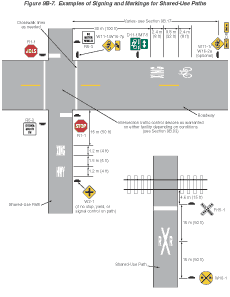
Section 9B.20 Bicycle Route Signs (M1-8, M1-9)
Option:
To establish a unique identification (route designation) for a State
or local bicycle route, the Bicycle Route (M1-8) sign (see Figure
9B-4) may be used.
Standard:
The Bicycle Route sign shall contain a route designation and shall
have a green background with a retroreflectorized white legend and
border.
Option:
Where a designated bicycle route extends for long distances through
two or more States, a coordinated submittal by the affected States
for an assignment of an Interstate Bicycle Route number designation
may be sent to the American Association of State Highway and Transportation
Officials (see Addresses).
Standard:
The Interstate Bicycle Route (M1-9) sign (see Figure 9B-4) shall
contain the assigned route number designation and have a black legend
and border with a retroreflectorized white background.
Guidance:
If used, the Bicycle Route or Interstate Bicycle Route signs should
be placed at intervals frequent enough to keep bicyclists informed
of changes in route direction and to remind motorists of the presence
of bicyclists.
Option:
Bicycle Route or Interstate Bicycle Route signs may be installed
on shared roadways or on shared-use paths to provide guidance for
bicyclists.
The Bicycle Route Guide (D11-1) sign (see Figure 9B-4) may be installed where no unique designation of routes is desired.
Section 9B.21 Destination Arrow and Supplemental Plaque Signs for Bicycle Route Signs
Option:
Destination (D1-1b and D1-1c) signs (see Figure 9B-4) may be mounted
below Bicycle Route Guide signs, Bicycle Route signs, or Interstate
Bicycle Route signs to furnish additional information, such as directional
changes in the route, or intermittent distance and destination information.
The M4-11 through M4-13 supplemental plaques (see Figure 9B-4) may be mounted above the appropriate Bicycle Route Guide signs, Bicycle Route signs, or Interstate Bicycle Route signs.
Guidance:
If used, the appropriate arrow (M7-1 through M7-7) sign (see Figure
9B-4) should be placed below the Bicycle Route Guide sign, Bicycle
Route sign, or Interstate Bicycle Route sign.
Standard:
The arrow signs and supplemental plaques used with the D11-1 or
M1-8 signs shall have a white legend and border on a green background.
The arrow signs and supplemental plaques used with the M1-9 sign shall have a white legend and border on a black background.
Section 9B.22 Bicycle Parking Area Sign (D4-3)
Option:
The Bicycle Parking Area (D4-3) sign (see Figure
9B-4) may be installed where it is desirable to show the direction
to a designated bicycle parking area. The arrow may be reversed
as appropriate.
Standard:
The legend and border of the Bicycle Parking Area sign shall be
green on a retroreflectorized white background.
